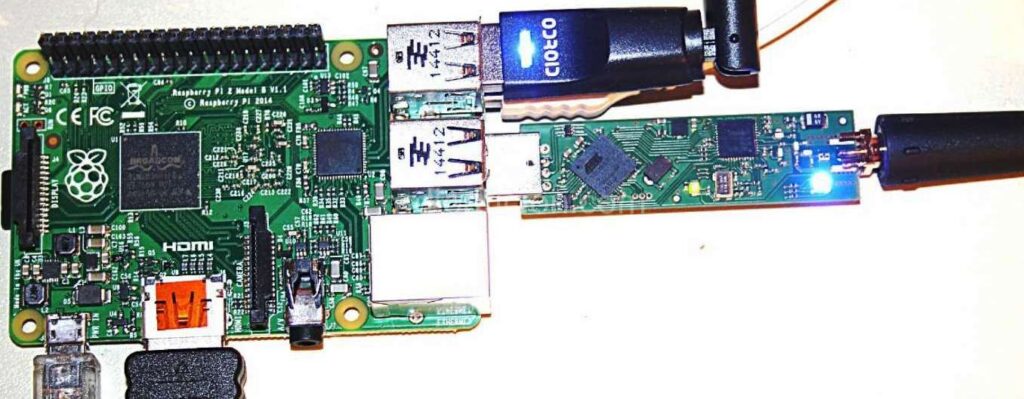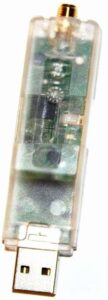DV4mini

DV4miniD-Star/DMR Hotspot USB Stick
The DV4mini is a very small but also very capable USB Stick that can expand any PC into a Hotspot for the D-STAR and DMR modes (C4FM Fusion is in development).
It consists of a powerful 32 bit micro controller, a complete 70 cm transceiver and a modulator/demodulator for GMSK and 4FSK (incl. Raised Cosine) and also a USB interface.
The DV4mini does not require external power as it is powered via the USB interface. The DV4mini is supplied together with a simple to use and comprehensive software package. This allows linking with DCS, XRF and REF reflectors for D-STAR as well s DMR reflectors.
Many hams have a DV capable transceiver but cannot reach the closest DV repeater. With the DV4mini it has become possible to create a hotspot with minimal resources and thus get access to the DV network. We are talking about a small board inside a USB stick with a SMA antenna socket.
These components are a prerequisite:
1. DV4mini USB stick
2. PC Software: DV4mini Control Panel
3. A DV capable radio (D-Star, DMR)
4. A PC with Windows XP, 7, 8.1, 10; Linux on a PC or an ARM computer like a Raspberry, Banana Pi or Odroid.
5. Internet access
The DV4mini will be connected thru the USB interface with a PC or a single board computer and the required software will be installed. After starting and setting up the software one now has a Hotspot for the 70 cm band and can use it with a D-STAR or DMR transceiver.
This picture shows a DV4mini connected to a Raspberry PI 2 Mod. B:
DV4mini connected to a Raspberry PI 2 Mod. B
On the upper right is a WLAN stick and below it the DV4mini. In addition there are also connections to a keyboard, a mouse and a HDMI display. This configuration allows for a power saving continuous operation at low expense.
Reflectors:
A reflector is a server connected to the Internet or Ham Net and is linked to a number of digital Ham Radio repeaters. If one of these repeaters is active it will send the voice data stream to the reflector. The reflector sends a copy of these voice data to all of the connected repeaters. This means that a QSO can be heard on all connected repeaters simultaneously.
Thus the chance to find a QSO partner is considerably increased – which is one of the reasons relectors are quite popular.
Today the following systems are in operation:
DCS (Digital Call Server):
DCS is the most modern D-STAR reflector system and in worldwide use. Many countries use their own reflectors which differ from each other by their 3 digit number. (DCS001, DCS002 etc).
Each DCS reflector has 26 rooms which are allocated to various regions of a country or continent. These rooms (A to Z) have been given names to make their identification easier and are shown on the user surface of the DV4mini.
Xreflector:
Xreflectors are the second generation of D-STAR reflectors and no longer widely in use. However in some countries like Italy they are still used as the hams have not yet agreed to a uniform concept.
Also Xrelectors have less ports over which simultaneous QSOs be run. Xrelectors are named XRF001, XRF002 etc.
D-Plus reflectors:
They were the first generation D-STAR reflector system. Although it is getting old it is still used intensively in a number of countries (mostly English speaking ones like USA, UK and Canada but even in Germany are a few operational). D-Plus relectors are named REF001, REF002 etc.
They also use a number of ports allowing for simultaneous QSOs.
DMR reflectors:
DMR reflectors consist of several regional servers that are connected with each other via a superordinate network. Two nets exist. One based on Hytera and the other based on Motorola technology. As Hytera is open towards Ham Radio the DV4mini sticks check into the Hytera based network. In the meantime there are also some cross connections existing that allow communication beyond ones net limits.
Net organization (CCS7):
The many reflectors, repeaters and also Dongle users (the DV4mini is a Dongle too) require a structured organization, so that the network technology works properly.
D-Star works with call signs to identify a station. DMR however uses numbers. That is why it is necessary that an amateur radio station gets a number assigned in addition to its call sign and that this call sign – number combination is known to the network.
Every ham can go to the web site xreflector.net and request a 7 digit number to be assigned. This number is then entered into the specific field on the DV4mini software. This facilitates reporting into the network and conduct worldwide contacts in D-Star or DMR and the use of D-Star/DMR bridges.
Operating modes:
Digital ham radio repeaters are connected via relectors. This allows for worldwide connections from one repeater to another.
With a hotspot (DV4mini) one creates ones own connection to this relector network and gets access to all connected ham radio repeaters.
The hotspot includes a low power 70 cm transceiver. All voice communications on the connected reflector will be transmitted by the hotspot on 70 cm and one can listen with a digital radio and of course also transmit.
Thus a hotspot is an ideal solution in one has no good access to a digital repeater e.g. inside buildings, due to distance or at a vacation spot.
For such a hotspot you use your own call sign. Reduce your transmit power to just enough to cover your living area for reliable communication.
Hardware:
Use the Hotspot Mode to enter the frequency to be utilized for DV operation. (check your band plan).
Your transceiver will be set up for Simplex use – RX and TX on the same frequency.
The DV4mini takes the 5 Volt operating voltage from the USB interface. On a few PCs this voltage however may be too low (we measured below 4.5 V on some). In this case you can’t operate.
The best solution is then to use a USB adapter with its own power supply.
Technical Data:
Frequency range: 420-450 MHz
Resolution: ca 250 Hz
RX/TX D-Star: Duplex +/0/- any shift
RX/TX DMR: Simplex (TX=RX QRG) Modulation D-Star: GMSK (Gaussian 2FSK)
Modulation DMRPLUS: 4FSK Raised Cosine
Antenna connector: SMA female 50 Ohm
USB interface: USB type A
Operating Voltage: 4.75 – 5.25 V
Current max RX: 15 mA
TX (with 12 mW) 188 mA
S-Meter 1dBm resolution
accuracy +- 1dBm (> -100 dBm and <-50dBm)
DV4mini output power steps: 10 steps
0 = 0.03 mW
1 = 0.4 mW
2 = 1.2 mW
3 = 2.4 mW
4 = 3.9 mW
5 = 5.5 mW
6 = 7.1 mW
7 = 8.8 mW
8 = 10.5 mW
9 = 12 mW
Antenna:
Comply with your country’s regulations regarding automatic operation!
The DV4mini requires an antenna. It must not be used without an antenna. You can use the commonly available ‘rubber ducks’ with a SMA connector like the ones used with walkies. The DV4mini must not be connected to a high Yagi or similar antenna.
If you use a physically adjustable antenna, be careful that when you adjust the position of the antenna you hold onto the base and not the housing. Otherwise you may damage the SMA connector. The DV4mini must be used only when you are nearby. Unmanned operation requires in almost all countries separate licenses or permits.
ATTENTION: Do not overload the SMA connector when handling the antenna. Always hold on to the base and not the stick. Damaged SMA connectors are not covered by warranty.
In order to utilize the stick in many countries the DV4mini covers a large range of frequencies from 420 to 450 MHz. It is the operators responsibility to utilize only the frequencies appropriate in his country.
Copyright:
The rights for the DV4mini stick and its software are reserved with DG8FAC (Stefan Reimann), DG1HT (Torsten Schultze) and DJ0ABR (Kurt Moraw).

